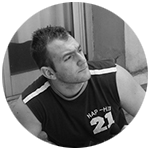Full video at 60 fps
21mbit video at 59,94 fps – h264 – 1280 x 720 Progressive
Adopted Workflow
Placing of Markers (smaller closer and larger on the distant wall) – FAILED ON CLOSE WALL
Placing of Markers on the hood (Driver’s head)
Retention of the distance of a pair of background trackers and hood trackers for a correct scene scale
Testing of a possibile shots and choice of a fixed focal length
Different shots at 59fps, hd to reduce the rolling shutter on the sensor (less lines to scan)
Some 360 photos for HDR reconstruction, needed for a correct illumination and the reflex on the helmet
Some 360 photos for the Helmet reconstruction.
Removal of Rolling Shutter, Camera Tracking and estimation of the focal length (MISSING CHECKERBOARD REFERENCE)
Again, from the source, Removal of Lens distortion calculated from the previous step, Rolling Shutter, Camera Tracking, Object Solving, Scene scale and export
Removal of Distorsion on the helmet shots. Camera tracking, export
Modeling of the Helmet, creation of multiple uvs ids, texturing, painting
Scene HDR creation and tone mapping.
Integration of the helmet in the scene, animation, lighting and rendering (material passes, ambient occlusion, object mattes,motion blur vectors)
Compositing, trackers removal and general fixes.
Color grading.
Problems and fixes
Red markers and the spring around the neck
Trackers through car windows
HDR References
Object Reconstruction References
Head Reconstruction
Camera Tracking References
Backstage












































































































